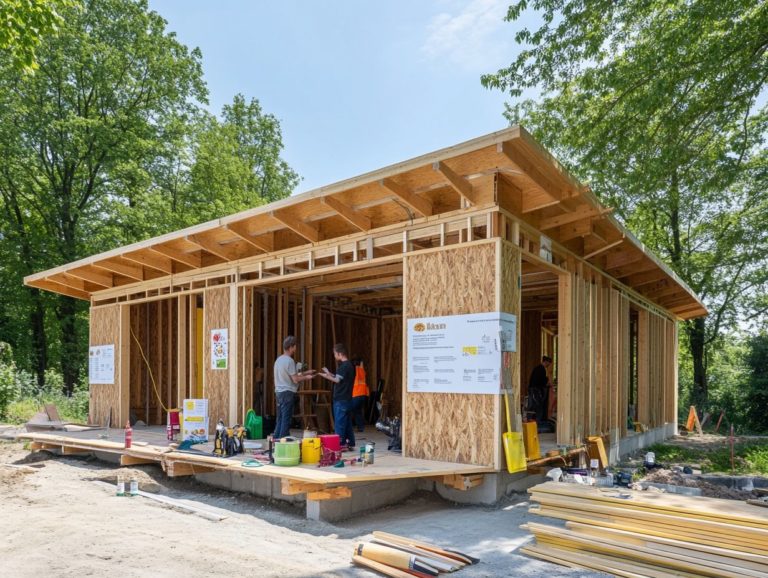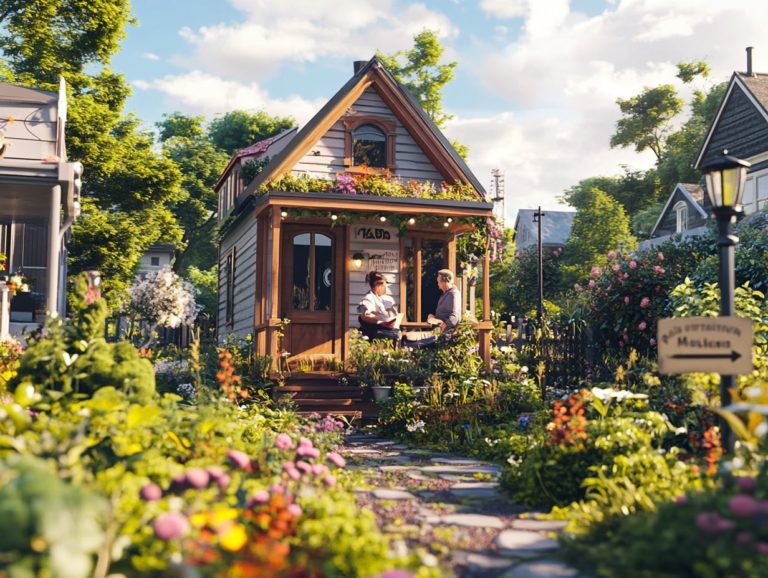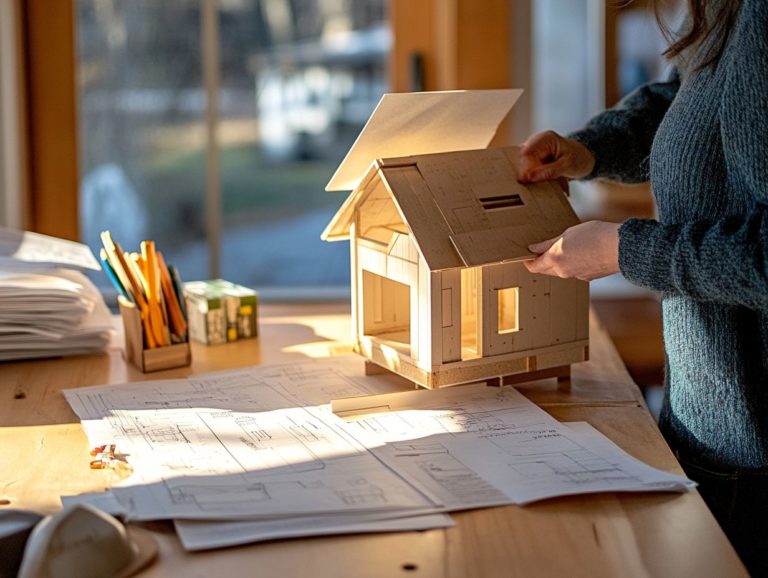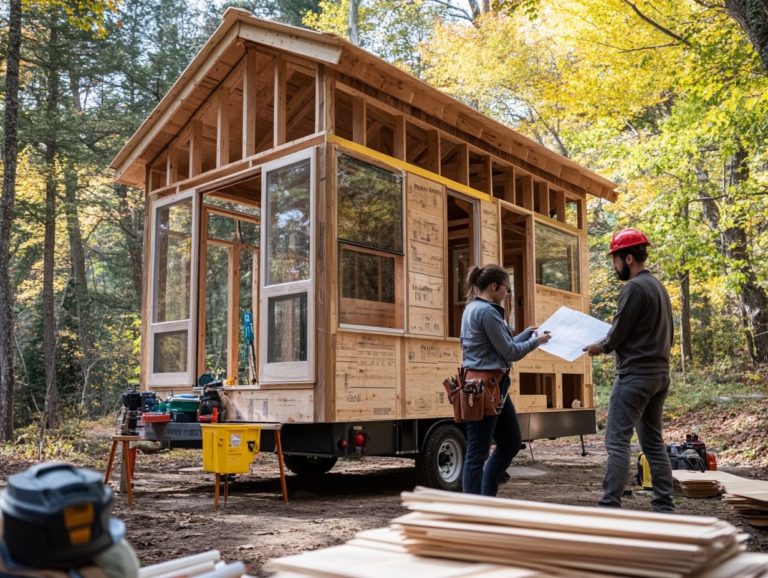Tiny House Living and Legal Protections
Tiny house living transcends mere trendiness; it represents a lifestyle choice that champions simplicity, sustainability, and the exhilarating sense of freedom. Dive into this article to discover the exciting world of tiny house living!
This article illuminates the true essence of tiny house living, highlighting its defining characteristics and the myriad benefits it offers. From significant economic savings to a positive impact on the environment, particularly through affordable housing options, tiny house living has much to offer.
This article explores the complex legal side of tiny house living, shedding light on rules about where you can place your tiny house and alternative protections available for those embracing this unique way of life.
You’ll find insights into common challenges faced by tiny dwellers, along with practical steps to kickstart your own tiny home journey. For those considering a downsize or simply intrigued by this movement, exploring tiny house regulations and building practices offers valuable information waiting for you.
Contents [hide]
- Key Takeaways:
- What is Tiny House Living?
- Benefits of Tiny House Living
- Legal Protections for Tiny House Dwellers
- Challenges and Considerations for Tiny House Living
- How to Get Started with Tiny House Living
- Frequently Asked Questions
- What is tiny house living?
- Are there any legal protections for tiny house living?
- What challenges may arise when it comes to legal protections for tiny house living?
- What should I consider before choosing to live in a tiny house?
- Can I legally build my own tiny house?
- What should I do if my tiny house is not considered a legal residence?
Key Takeaways:
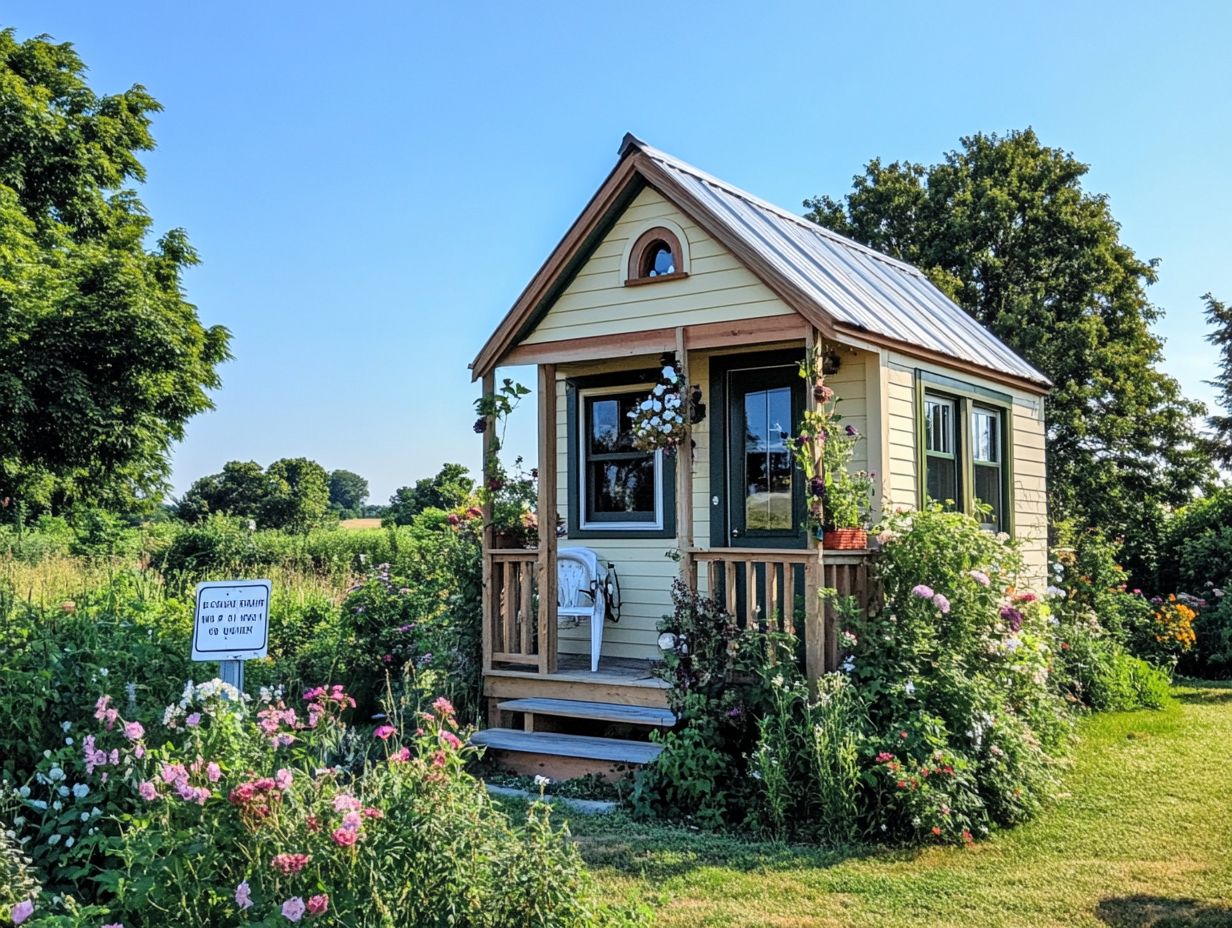
- Tiny house living offers economic and environmental benefits.
- Zoning laws can be barriers, but there are legal options to protect rights.
- Address common challenges before starting your tiny house journey.
What is Tiny House Living?
Tiny house living is a lifestyle choice you may find intriguing, embodying minimalism, which means living with fewer possessions to focus on what truly matters, through compact homes that typically range from 100 to 400 square feet, often referred to as tiny houses.
This choice allows you to reduce your impact on the environment while promoting the tiny house movement, encouraging a tiny home community. It’s an innovative approach to residential construction designed for those seeking affordable housing solutions and a simpler way of life. However, it’s important to understand tiny house parking legal guidelines to ensure compliance with local regulations.
In this limited space, aesthetics and functionality harmoniously converge, making it a compelling option for modern dwellers like you who prioritize sustainability, especially within the tiny home context.
Definition and Characteristics
A tiny house, typically defined as a dwelling under 400 square feet, represents a captivating fusion of aesthetic charm and practical functionality, meticulously crafted for compact living without compromising on essential comforts.
These homes offer remarkable versatility, whether they re built on a mobile chassis for those who crave a nomadic lifestyle or anchored to a permanent foundation that complies with building codes for stability and permanence.
Layout considerations are crucial; every square inch is designed with intention, ensuring optimal use of space. Rooms are thoughtfully arranged to create an open atmosphere, often enhanced by large windows that flood the interiors with natural light and a palette of creative color schemes, reflecting the principles of the Tiny House Movement.
By adhering to guidelines like maintaining a minimum ceiling height, tiny homes not only foster a sense of spaciousness but also enrich livability, creating an inviting ambiance that meets international building code standards. This thoughtful orchestration of design principles elevates the allure of tiny homes while fostering a deeper connection to the surrounding environment and supporting affordable housing initiatives.
Benefits of Tiny House Living
Embracing tiny house living presents a wealth of advantages, especially in terms of economic and environmental benefits. This lifestyle choice can be particularly appealing for those looking to downsize, achieve financial freedom, and significantly reduce their carbon footprint to live more sustainably.
Tiny house living not only saves money but also helps you live lightly on the planet. It’s a compelling path for individuals seeking simplicity and sustainability in their lives, reflecting the values of the tiny house movement. However, it’s important to be aware of tiny house residency laws you should know to ensure a smooth transition into this lifestyle.
Economic and Environmental Advantages

The economic benefits of tiny house living are strong. You ll see reduced expenses on property and utilities, especially for property insurance.
Living in a tiny house means lower energy consumption and a smaller ecological footprint. This lifestyle is sustainable and reflects the principles of minimal living.
By simplifying your space, you can cut down on property insurance costs. These homes often need less coverage due to their smaller size and overall value.
Maintenance and home improvement costs for tiny houses are generally lower. This allows you to save money or invest in enriching experiences instead of home renovations.
This financial flexibility is appealing, especially in a housing market that values affordability and sustainable living.
Tiny homes align with a minimalist lifestyle that reduces waste. They encourage eco-friendly choices, supporting the goals of the tiny house movement.
As more people embrace this trend, it can lead to innovative building practices. These practices can reshape the housing landscape and make affordable options accessible to all.
Legal Protections for Tiny House Dwellers
Navigating the legal protections for tiny house dwellers can be complex. Laws and regulations vary widely by local government and are often influenced by zoning laws and building codes.
Understanding these regulations is crucial for anyone considering the tiny house lifestyle, especially in states like California and Florida.
Zoning Laws and Regulations
Zoning laws and building codes are key to determining where you can legally live in a tiny house. Local regulations significantly affect your options.
It s important to understand that zoning regulations can differ by state. These laws dictate everything from setback distances to utility connections.
While federal laws provide a general framework, states like Arizona and Alaska have unique rules that can complicate your plans.
As a tiny house enthusiast, consider possible options like living in RV parks or tiny home communities. Each has specific restrictions you need to follow.
Understanding these legal nuances is vital for enjoying your sustainable lifestyle to the fullest.
Alternative Options for Legal Protection
If you’re facing restrictive zoning laws, explore options like small secondary homes or tiny home communities. These can provide viable legal living arrangements.
These choices promote a flexible lifestyle and help create a sense of community among residents who value minimalism and sustainability.
In RV parks, tiny house owners benefit from established infrastructure that meets zoning requirements. This helps avoid legal issues.
By considering these alternatives, you can find a stable residence in a tiny house community while achieving your dream of affordable living.
Challenges and Considerations for Tiny House Living

While the tiny house movement celebrates a lifestyle rooted in simplicity and minimalism, be mindful of the challenges and obstacles that may arise on your journey toward compact living.
It’s essential to navigate the legal requirements and explore housing options. This includes understanding building codes and tiny house living guidelines, ensuring you are well-prepared for this transformative experience.
Overcoming Tiny House Hurdles
Entering the tiny house movement presents unique challenges, such as navigating complex legal requirements and dealing with local building departments.
You will also need to address the concerns of planning commissions regarding safety and compliance. Securing the necessary permits can feel overwhelming, especially when ensuring your designs meet minimum ceiling height requirements established by tiny house land use laws.
Finding suitable financing options adds another layer of complexity since traditional lenders often see tiny homes as unconventional investments. Understanding the legal status of tiny houses can also be crucial in navigating these challenges.
To navigate these challenges, consult local experts familiar with tiny house laws. Their insights can help you overcome government processes related to building codes and appeal decisions from planning commissions. Additionally, understanding tiny house zoning laws can be crucial in ensuring compliance.
Fostering community support can sway opinions and create a favorable environment for innovative housing solutions, like those found in tiny house communities. Understanding the legal myths of tiny house living can also help in promoting these solutions.
How to Get Started with Tiny House Living
Embarking on tiny house living involves strategic steps and thoughtful decisions to facilitate a smooth transition. Begin by connecting with reputable tiny home builders knowledgeable about tiny house regulations and exploring available housing options.
This foundational approach will pave the way for your new, simplified way of living.
Steps to Take and Resources to Use
Start your journey into tiny house living by researching reputable tiny home builders and familiarizing yourself with resources tailored to your preferred housing options.
Planning is key. Your design choices will affect how well you use space and functionality. Don’t overlook the importance of understanding local regulations, as each area has specific zoning laws and building codes.
As a prospective tiny house owner, you’ll discover abundant resources available, such as the Tiny House Society and forums where fellow enthusiasts share valuable insights. For a comprehensive overview, refer to tiny house regulations: a state-by-state guide that can further enrich your knowledge, empowering you to make informed decisions that align with your vision of compact living.
Frequently Asked Questions
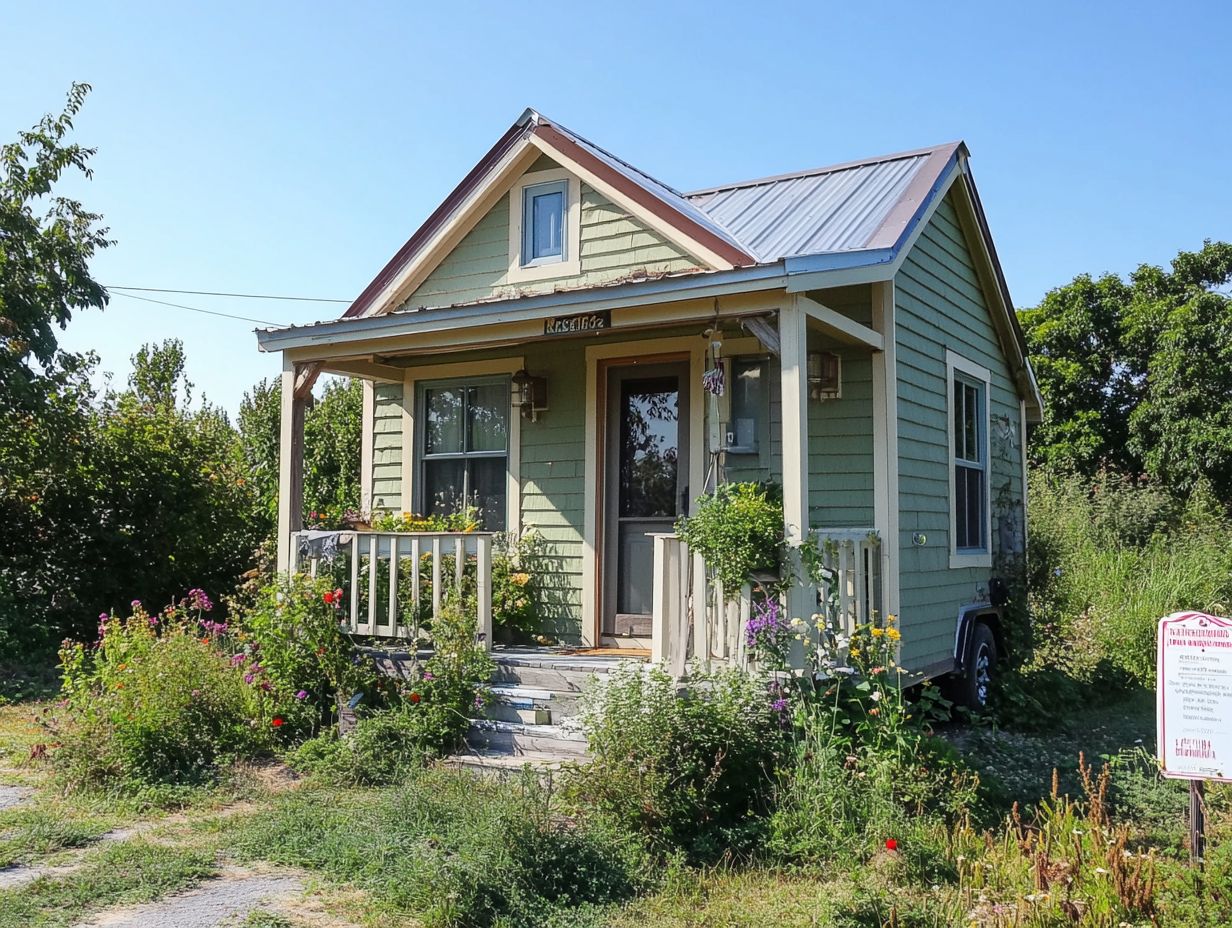
What is tiny house living?
Tiny house living is a lifestyle where individuals or families choose to live in small, compact homes typically less than 400 square feet. These homes are designed to use space efficiently and often embrace a minimalist approach.
Are there any legal protections for tiny house living?
Currently, there are limited legal protections for tiny house living. However, some states and cities are developing zoning laws and building codes specifically for tiny homes, allowing them to be legally occupied as primary residences.
What challenges may arise when it comes to legal protections for tiny house living?
One major challenge is that traditional building codes and zoning laws might not consider the unique characteristics of tiny homes. This can make it difficult for these homes to be legally occupied, particularly as primary residences.
Ready to dive into tiny house living? Start your research today!
What should I consider before choosing to live in a tiny house?
Before deciding to live in a tiny house, research local laws. Understanding regulations is crucial for a smooth transition.
Consider the challenges and benefits of this lifestyle. Think about your personal needs and how they align with tiny living.
Can I legally build my own tiny house?
Building codes vary by location. Check with your local government before starting construction on your tiny house.
Some areas may require permits and inspections. Others might have lenient rules for tiny homes.
What should I do if my tiny house is not considered a legal residence?
If your tiny house isn’t recognized as a legal residence, consult a lawyer or local officials. They can guide you on exploring your options.
You may need to obtain a variance from zoning laws. Advocating for regulatory changes could also be a potential solution.


